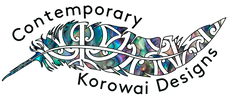FAQ'S
KOROWAI/KAKAHU
1. How long will it take to make my korowai?
Our current turnaround time is max 1 week.
2. What if I have an urgent order?
Please don't be afraid to ask, as we may be able to squeeze your urgent order in.
3. How do I know what size will fit me best?
Check out our size chart.
4. What feathers do you use?
We use quality hen and rooster feathers.
5. Where are these made?
They are made in Wainuiomata, Wellington, New Zealand.
6. Do you have any in stock?
We usually have a very limited amount of korowai in stock, contact us to find out what stock we currently have.
7. How long is shipping.
National - I send by tracked overnight courier in NZ and your parcel should be with you within 1-2 days.
International - I send via International Courier which is tracked and delivery target is 5-10 working days.
8. What is the meaning of the different taniko bands?
Moroki - This is a new design and was created by my 23yr old daughter Jade Paki (Ngati Apa & Ngati Tuwharetoa). She named it Moroki which means modern or contemporary.
Whanake - This was designed by my brother in law Horace Taiapa and is based on the teeth of the niho taniwha. It was named Whanake by his daughter Ani, and it means to grow and develop.
Aramoana - is a common Maori design and means Pathway of the Sea. The horizontal zigzags suggest pathways that the ocean and other waterways provide to many destinations.
Rangitamiro - This is our newest Taniko band. It was designed by my niece Georgia Taiapa. I wanted this bad to be inspired by whanau and bringing whanau together. She came up with this beautiful design and named it after her daughter, my great niece Mairangi-Rangitamiro
CARVINGS
1. Are the wood carvings on your website strictly handmade?
All are made in New Zealand. Some of the stock wood pieces are made using a combination of machine and hand finishing. Wood pieces by featured artists such as Thomas Hansen and Andy Little are made exclusively with hand chisels only.
All bone pieces are totally hand carved.
2. What bone are the bone carvings made from?
The pieces on our site are all carved from cow bone or deer antler which are now the only readily available sources of bone suitable for carving.
Cow bone is very fine grained, very dense and also thick enough to make the larger pieces. It is the high density and fine grain of the bone that gives it the ability to hold such a high gloss polish and fine engraving details.
Deer antler is a softer more porous material very similar to whale bone which allows us to make large carvings that do not weigh too much. It generally has a matt finish and lots of colour variations making each piece unique.
We do not use whale bone. Whale bone is covered under the CITES agreement relating to the trade in endangered species. As such every piece of bone and every carving must have its own cites permit issued by the department of conservation to be able to take it out of the country or into another country such as Australia.
In some countries you also need to have a special import permit as well as the CITES permit. A CITES permit will cost anything from $80 up and will require proof of the source and a full history of the bone used from its original source to the current finished carving. Failure to have a cites permit will mean that it is very likely the piece will be confiscated and destroyed by customs and that you may be fined.
3. Does the koauau work or is it ornamental only?
The small wooden koauau is ornamental. That one just rests on the stand so it is not attached. It is a "touch piece" meant to be taken off the stand and touched.


